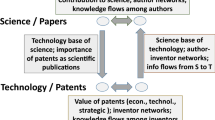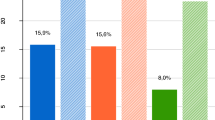Abstract
Patents relate the scientific, technological, and business dimensions of eco-systems. Based on the number of references to patents aggregated at the level of journals, we map two indicators of linkages between the sciences and technologies: patent intensity (PI) and patent density (PD). Journal maps can be overlaid with the values of PD and PI so that the portfolios can be visually identified and compared across fields. Patent citations are only systemic in Chemistry and Nano Science, but these linkages show declining trends. The continuity in terms of citing patents in successive years in these eco-systems are also significantly higher than in other fields. Patent citations are very specific in domains other than Chemistry and Nano Science. Patent citation in the Social Sciences, however, is above expectation.









Similar content being viewed by others
Notes
Two journals (Dutch Crossing and Z Bibl Bibl) are not connected with the largest component, thus, the practical number of journals being worked with is 11,677.
References
Bhattacharya, S., Kretschmer, H., & Meyer, M. (2003). Characterizing intellectual spaces between science and technology. Scientometrics,58(2), 369–390.
Brooks, H. (1994). The relationship between science and technology. Research Policy,23(5), 477–486.
Bush, V. (1945). Science—the endless frontier: A report to the President on a program for postwar scientific reseaerch. Washington, D.C.: U.S. Government Printing Office.
Carley, F., Newman, C., Porter, A., & Garner, G. (2018). An indicator of technical emergence. Scientometrics,115(1), 35–49.
Casimir, H. B. G. (1971). Industries and academic freedom. Research Policy,1(1), 3–8.
Glänzel, W., & Meyer, M. (2003). Patents cited in the scientific literature: An exploratory study of “reverse” citation relations. Scientometrics,58(2), 415–428.
Grupp, H., & Schmoch, U. (1992). Perceptions of scientification of innovation as measured by referencing between patents and papers: Dynamics in science-based fields of technology. In H. Grupp (Ed.), Dynamics of Science-Based Innovation (pp. 73–128). Berlin, Heidelberg: Springer. https://doi.org/10.1007/978-3-642-86467-4_4.
Hain, D. S., Jurowetzki, R., Lee, S., & Zhou, Y. (2019). Machine learning and AI for science, technology, and (Eco-)system mapping and forecasting. Scientometrics (in preparation).
Huang, M. H., Yang, H. W., & Chen, D. Z. (2015). Increasing science and technology linkages in fuel cells: A cross citation analysis of papers and patents. Journal of Informetrics,9(2), 237–249. https://doi.org/10.1016/j.joi.2015.02.001.
Kuhn, J. M., Younge, K. A., & Marco, A. (2020). Patent citations reexamined. The RAND Journal of Economics,51(1), 109–132.
Leydesdorff, L. (2000). Is the European Union becoming a single publication system? Scientometrics,47(2), 265–280.
Leydesdorff, L., Bornmann, L., & Wagner, C. S. (2017). Generating clustered journal maps: An automated system for hierarchical classification. Scientometrics,110(3), 1601–1614.
Leydesdorff, L., Carley, S., & Rafols, I. (2013). Global maps of science based on the new Web of Science categories. Scientometrics,94(2), 589–593.
Leydesdorff, L., & Ivanova, I. (2020). The measurement of “Interdisciplinarity” and “Synergy” in scientific and extra-scientific collaborations. Available at SSRN: https://ssrn.com/abstract_id=3560339. Accessed 21 Apr 2019.
Leydesdorff, L., & Meyer, M. (2007). The scientometrics of a Triple Helix of university-industry-government relations (introduction to the topical issue). Scientometrics,70(2), 207–222. https://doi.org/10.1007/s11192-007-0200-y.
Leydesdorff, L., & Rafols, I. (2009). A global map of science based on the ISI subject categories. Journal of the American Society for Information Science and Technology,60(2), 348–362.
Leydesdorff, L., & Rafols, I. (2012). Interactive overlays: A new method for generating global journal maps from web-of-science data. Journal of Informetrics,6(3), 318–332.
Meyer, M. (2000). Does science push technology? Patents citing scientific literature. Research Policy,29(3), 409–434. https://doi.org/10.1016/S0048-7333(99)00040-2.
Narayanamurti, V., & Odumosu, T. (2016). Cycles of invention and discovery: rethinking the endless frontier. Cambridge: Harvard University Press.
Narin, F., Hamilton, K. S., & Olivastro, D. (1997). The increasing linkages between U.S. technology and public science. Research Policy,26(5), 1307–1310.
Pielke, R. (2010). In retrospect: Science—the endless frontier. Nature,466(7309), 922–923.
Porter, A., Youtie, J., Carley, S., Newman, N., & Murdick, D. (2018). Contest: Measuring tech emergence. Paper presented at the 23rd international conference on science and technology indicators (STI 2018), September 12–14, 2018, Leiden, The Netherlands.
Porter, A. L., Garner, J., Carley, S. F., & Newman, N. C. (2019). Emergence scoring to identify frontier R&D topics and key players. Technological Forecasting and Social Change,146, 628–643. https://doi.org/10.1016/j.techfore.2018.04.016.
Price, D. J. S. (1984). The science/technology relationship, the craft of experimental science, and policy for the improvement of high technology innovation. Research Policy,13(1), 3–20.
Rafols, I., Porter, A. L., & Leydesdorff, L. (2009). Science overlay maps: A new tool for Research Policy and Library Management. Journal of the American Society for Information Science,60(1999), 2353–2361. https://doi.org/10.1002/asi.
Rafols, I., Porter, A. L., & Leydesdorff, L. (2010). Science overlay maps: A new tool for research policy and library management. Journal of the American Society for Information Science and Technology,61(9), 1871–1887.
Rakas, M., & Hain, D. S. (2019). The state of innovation system research: What happens beneath the surface? Research Policy, 48(9), 103787. https://doi.org/10.1016/j.respol.2019.04.011.
Rosenberg, N. (1969). The direction of technological change: Inducement mechanisms and focusing devices. Economic Development and Cultural Change,18(1), 1–24.
Rosenberg, N. (1982). Inside the black box: Technology and economics. Cambridge: Cambridge University Press.
Rotolo, D., Rafols, I., Hopkins, M. M., & Leydesdorff, L. (2017). Strategic intelligence on emerging technologies: Scientometric overlay mapping. Journal of the Association for Information Science and Technology,68(1), 214–233. https://doi.org/10.1002/asi.23631.
Shinn, T. (2005). New sources of radical innovation: Research-technologies, transversality and distributed learning in a post-industrial order. Social Science Information,44(4), 731–764.
Smith, K., Ekland, A., Iversen, E., Kaloudis, A., Patel, P., & Narula R. (1998). Understanding science, technology and innovation indicators. IDEA-Report 5/1998. Oslo: STEP Group.
van Eck, N. J., & Waltman, L. (2010). Software survey: VOSviewer, a computer program for bibliometric mapping. Scientometrics,84(2), 523–538.
Verbeek, A., Debackere, K., Luwel, M., Andries, P., Zimmermann, E., & Deleus, F. (2002). Linking science to technology: Using bibliographic references in patents to build linkages schemes. Scientometrics,54(3), 399–420.
Acknowledgements
Xiaozan Lyu and Ping Zhou acknowledge support by the National Science Foundation of China (NSFC), Grant Number 71843012; Zhejiang University, Grant Number: 16ZDJC003. We are grateful to Clarivate Analytics for providing the JCR data and to CWTS for the UT numbers of articles with patent citations.
Author information
Authors and Affiliations
Corresponding author
Rights and permissions
About this article
Cite this article
Lyu, X., Zhou, P. & Leydesdorff, L. Eco-system mapping of techno-science linkages at the level of scholarly journals and fields. Scientometrics 124, 2037–2055 (2020). https://doi.org/10.1007/s11192-020-03435-3
Received:
Published:
Issue Date:
DOI: https://doi.org/10.1007/s11192-020-03435-3




